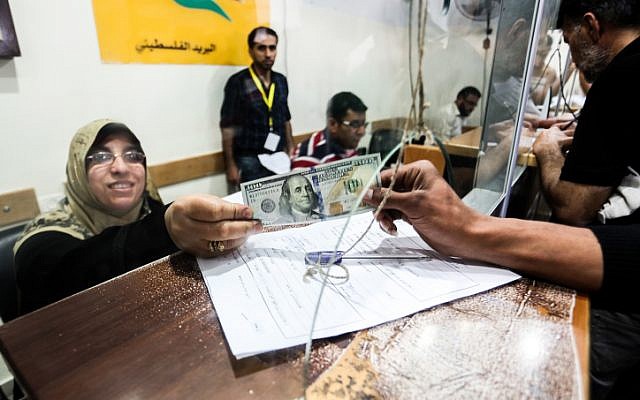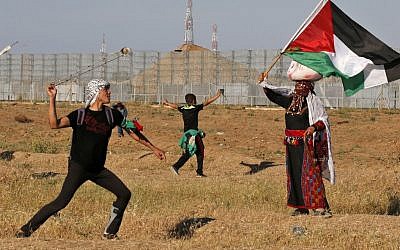Hamas: Israel implementing Gaza ceasefire agreement
Terror group’s assurances that the truce is still in place comes amid reports of delays in Qatar transferring funds to needy families in the Strip.

Palestinians receive their financial aid as part of $480 million in aid allocated by Qatar, at a post office in Gaza City on May 19, 2019. (Abed Rahim Khatib/Flash90)
The Gaza-ruling Hamas terror group on Wednesday said Israel was abiding by the terms of an unofficial ceasefire agreement reached last month.
In a statement, Hamas spokesman Hazem Qassim said third-party mediators had assured the group that Israel would be implementing a “broader package” of concessions in the coming days, including allowing financial aid into Gaza, addressing the electricity and water crises in the Strip, establishing employment programs and “facilitating the movement of Palestinians through border crossings.”
Qassim’s assurance that Israel was fulfilling its obligations under the deal came after a report Wednesday in the Lebanese al-Akhbar newspaper, which claimed that Jerusalem had prevented the transfer of Qatari funds to approximately 5,000 needy families in Gaza.
Qatar’s envoy to Gaza, Mohammed Al-Emadi, denied the reports, saying the delay in transferring the funds to the families was due to a decision to put that money toward development projects instead of direct financial aid.
Israel does not officially acknowledge a ceasefire agreement with Hamas and the other terror groups in the Strip that was brokered in early May following an intense two days of fighting.

A picture taken in Gaza City on May 5, 2019, shows rockets being fired toward Israel. (Mahmud Hams/AFP)
Under the truce, Hamas reportedly agreed to halt violent incidents along the border fence, maintaining a buffer zone 300 meters from the border; end the launching of incendiary balloons at Israeli communities and nighttime clashes between Gazans and security forces; and stop the flotillas trying to break through the naval blockade of the Gaza Strip.
In return, Israel agreed to allow Qatar to send money into Gaza; expand the fishing zone; enable United Nations cash-for-work programs; allow medicine and other humanitarian aid into the Strip; and open negotiations on matters relating to electricity, crossings and healthcare.
Hamas has largely prevented violence during border protests, turning back and arresting rioters who get too close to the security fence, and has stopped the flotillas. However, the flow of balloon-borne incendiary and explosive devices has not stopped in the past month and a half, and is widely seen by Israeli analysts as a tool with which the group can exert pressure on Israel.

A protester hurls stones at Israeli troops as a woman wearing a traditional Palestinian outfit waves a national flag, during a demonstration near the border with Israel, east of Gaza City, on May 10, 2019. (Said KHATIB / AFP)
Despite the ongoing arson attacks, Israel has also implemented the unofficial ceasefire agreement.
Israel’s national water company, Mekorot, began work this week on an upgraded pipeline to Gaza that will increase the flow of drinkable water into the blockaded enclave, which lacks potable water.
Israel will also reportedly build a new pipeline to take raw sewage that has been spilling into the country from the Gaza Strip and process it on the Israeli side.
A Qatari team of engineers also visited the area to discuss the construction of another electrical line into the Gaza Strip from Israel.
Emadi, who frequently liaises with Hamas, the Palestinian Authority and Israel about Gaza, entered the coastal enclave on Sunday through the Erez crossing, the sole pedestrian passageway between the Jewish state and the Strip. Emadi told the Qatari satellite broadcaster Al-Jazeera on Sunday that 100,000 poor families will each receive payouts in the form of a $100 bill.

Construction work on a fourth pipeline slated to carry freshwater into the central Gaza Strip, from the Eshkol Regional Council area in southern Israel, June 2019. (YouTube screen capture)
Fifty-three percent of Palestinians in Gaza live in poverty, a June 2018 United Nations report said. Eighty percent depend on international aid, according to the UN Relief and Works Agency, the main international organization that provides health, education and other services to Palestinian refugees.
Last week, Palestinian terrorists in the Gaza Strip fired two rockets at southern Israel. One was intercepted by the Iron Dome missile defense system as it was heading toward the Eshkol region of southern Israel. The second struck a religious school in the town of Sderot, causing damage to the building but no injuries.
In response, the Israeli military conducted a series of airstrikes against Hamas targets in the Gaza Strip.
Adam Rasgon contributed to this report.
Source: http://www.garnertedarmstrong.org/wp-admin/post-new.php